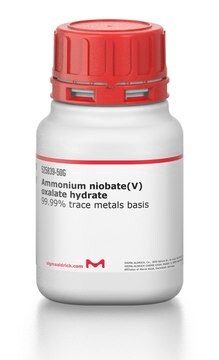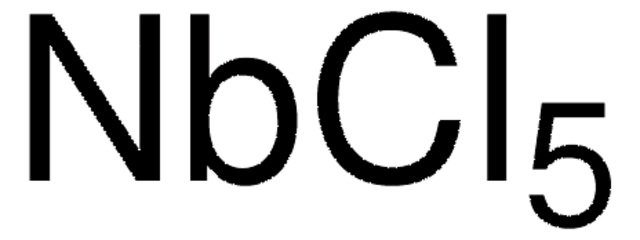463922
Ammonium metatungstate hydrate
99.99% trace metals basis
Synonym(s):
Ammonium tungsten oxide hydrate, Hexaammonium wolframate hydrate
About This Item
Recommended Products
Assay
99.99% trace metals basis
form
powder
reaction suitability
reagent type: catalyst
core: tungsten
impurities
≤150.0 ppm Trace Metal Analysis
mp
100 °C (dec.) (lit.)
SMILES string
N.N.N.N.N.N.O.O[W]1O[W](O)(=O)(O1)O[W]2(=O)(=O)O[W](O)(=O)(O2)O[W]3(=O)(=O)O[W](O)(=O)(O3)O[W]4(=O)(=O)O[W](O)(=O)(O[W]5(=O)(=O)O[W](O)(=O)(O[W]6(=O)(=O)O[W](O)(O)O6)O5)O4
InChI
1S/6H3N.9H2O.32O.12W/h6*1H3;9*1H2;;;;;;;;;;;;;;;;;;;;;;;;;;;;;;;;;;;;;;;;;;;;/q;;;;;;;;;;;;;;;;;;;;;;;;;;;;;;;;;;;;;;;;;;;;;;;;;;;;6*+1;+2/p-8
InChI key
ZBHPUDGBNLMJQH-UHFFFAOYSA-F
Looking for similar products? Visit Product Comparison Guide
Related Categories
General description
Application
- Carbon-supported tungsten catalyst for hydrogenolysis of cellulose.
- Reduced tungsten and mixed tungsten oxide catalysts for bifunctional hydroisomerization of n-alkanes.
- Hybrid 2D/3D tungsten diselenide transistors via chemical vapor deposition method.
Signal Word
Danger
Hazard Statements
Precautionary Statements
Hazard Classifications
Acute Tox. 4 Oral - Eye Dam. 1
Storage Class Code
11 - Combustible Solids
WGK
WGK 2
Flash Point(F)
Not applicable
Flash Point(C)
Not applicable
Personal Protective Equipment
Choose from one of the most recent versions:
Already Own This Product?
Find documentation for the products that you have recently purchased in the Document Library.
Customers Also Viewed
Our team of scientists has experience in all areas of research including Life Science, Material Science, Chemical Synthesis, Chromatography, Analytical and many others.
Contact Technical Service











